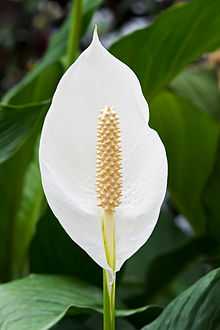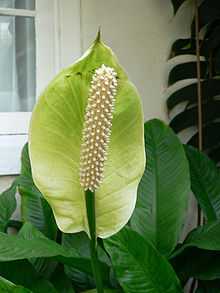Spathiphyllum
| Spathiphyllum | |
|---|---|
 | |
| Spathiphyllum cochlearispathum | |
| Scientific classification | |
| Kingdom: | Plantae |
| (unranked): | Angiosperms |
| (unranked): | Monocots |
| Order: | Alismatales |
| Family: | Araceae |
| Subfamily: | Monsteroideae |
| Tribe: | Spathiphylleae |
| Genus: | Spathiphyllum Schott |
| Species | |
|
See text | |
 | |
| Map of the natural distribution | |
Spathiphyllum is a genus of about 40 species of monocotyledonous flowering plants in the family Araceae, native to tropical regions of the Americas and southeastern Asia. Certain species of Spathiphyllum are commonly known as Spath or Peace Lilies.
They are evergreen herbaceous perennial plants with large leaves 12–65 cm long and 3–25 cm broad. The flowers are produced in a spadix, surrounded by a 10–30 cm long, white, yellowish, or greenish spathe. The plant does not need large amounts of light or water to survive.
Selected species
Species include:[1]
- Spathiphyllum atrovirens
- Spathiphyllum bariense
- Spathiphyllum blandum
- Spathiphyllum brevirostre
- Spathiphyllum cochlearispathum
- Spathiphyllum commutatum
- Spathiphyllum cuspidatum
- Spathiphyllum floribundum
- Spathiphyllum friedrichsthalii
- Spathiphyllum fulvovirens
- Spathiphyllum gardneri
- Spathiphyllum grandifolium
- Spathiphyllum jejunum
- Spathiphyllum juninense
- Spathiphyllum kalbreyeri
- Spathiphyllum kochii
- Spathiphyllum laeve
- Spathiphyllum lechlerianum
- Spathiphyllum maguirei
- Spathiphyllum mawarinumae
- Spathiphyllum monachinoi
- Spathiphyllum montanum
- Spathiphyllum neblinae
- Spathiphyllum patini
- Spathiphyllum perezii
- Spathiphyllum phryniifolium
- Spathiphyllum quindiuense
- Spathiphyllum silvicola
- Spathiphyllum solomonense
- Spathiphyllum wallisii
- Spathiphyllum wendlandii
Cultivated hybrids include:[2]
- Spathiphyllum × clevelandii
Cultivation and uses
Several species are popular indoor houseplants. Spathiphyllum cleans indoor air of many environmental contaminants, including benzene, formaldehyde, and other pollutants.[3][4] It cleans best at one plant per 10 m3.[5] It lives best in shade and needs little sunlight to thrive. It is watered approximately once a week. The soil is best left moist but only needs watering if the soil is dry.
Toxicity
Spathiphyllum is mildly toxic to humans and animals when ingested.[6][7] The Peace Lily is not a true lily from the Liliaceae family. True lilies, as well as onions and garlic, are much more toxic to cats and dogs.[citation needed] The Peace Lily contains calcium oxalate crystals, which can cause skin irritation, a burning sensation in the mouth, difficulty swallowing, and nausea.
-

Spathiphyllum cochlearispathum
-

Spathiphyllum cochlearispathum
-

Spathiphyllum floribundum
-

Spathiphyllum floribundum
References
- ↑ "The Plant List: A Working List of All Plant Species".
- ↑ Edward F. Gilman (1999). "Spathiphyllum x ‘Clevelandii’, Fact Sheet FPS-555". University of Florida Cooperative Extension Service.
- ↑ Anne Raver (February 13, 1994). "Need an Air Freshener? Try Plants". New York Times.
- ↑ HGTV - The Best Houseplants for a Healthy Home
- ↑ "How many plants are optimal". Air So Pure. Retrieved 14 January 2009.
- ↑ University of California -- Toxic Plants (list)
- ↑ http://www.entirelypets.com/toxicplants.html EntirelyPets.com article
External links
| Wikimedia Commons has media related to Spathiphyllum. |